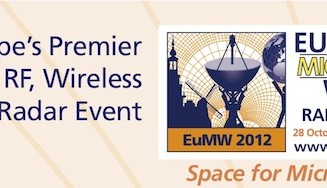European Microwave Week: The Future of Wireless
November 01, 2012
on
on

A week-long celebration of the electromagnetic spectrum is taking place from October 28 to November 2 at the European Microwave Week (EUMW). The event covers a wide range of subjects including antenna’s, radar systems, wireless technologies, integrated circuits, semiconductor materials and –of course- microwave systems.
Microwave Week includes The European Microwave Conference (EuMC), The European Microwave Integrated Circuits Conference (EuMIC), The European Radar Conference (EuRAD) and the Defense, Security and Space Forum. The 15th edition is being held in Amsterdam, The Netherlands.
The Future of Wireless
Keynote speaker Yrjö Neuvo from Aalto University, Finland and former CTO of Nokia contemplated the future of wireless technology in his speech. Mobile data traffic is doubling annually, a thousand-fold increase in ten years. These numbers show that mobile data is growing even more aggressively than computing power. Which –in accordance with Moore’s Law- doubles every two years.
This means that wireless data transfer capacity must step up to the plate. And according to Neuvo there is consensus amongst manufacturers that it is possible to achieve a thousand-fold increase of capacity in a decade. This technological optimism is based on three components. First, a denser deployment of base stations. Second, spectrum efficiency improvements: there will be better radio, encoding and transmission techniques. Also, developments in semiconductor technologies will support efficiency. And thirdly there will be access to additional spectrum.
Enough spectrum available
‘There is a lot of unused spectrum still available to us’, Neuvo said. For instance TV-bands aren’t used optimally, there is a lot of white space up for grabs. It would be a good thing if whitespace was released for unlicensed Radio Frequency (RF) devices, these then could be named TV-band devices or TVBDs.
‘Take for instance mobile phones, second generation wireless phone technology (2G) covered only two bands. 3G has nine bands and 4G seventeen. For cell phone manufacturers this means that, in principle, the phones you make should be able to cover all these frequencies. In practice however, it does not work like that, you optimize a phone for a certain market’, said the former Nokia CTO.
All of these developments are a great opportunity for RF research and innovation. In the future we will be heading for Software Defined Radio (SDR) which will eliminate the need to have different devices for different frequencies. Today technologies like GPS, Bluetooth, Wireless LAN each need there own dedicated device (or component in a device). SDR will enable us to have one hardware platform capable of covering a frequency range from, say, 600MHz to 6GHz.
Neuvo concluded with his view that wireless technology and ICT continues as a major catalyst of innovation showing no sign of saturation.
Image: EUMW12 Logo
Microwave Week includes The European Microwave Conference (EuMC), The European Microwave Integrated Circuits Conference (EuMIC), The European Radar Conference (EuRAD) and the Defense, Security and Space Forum. The 15th edition is being held in Amsterdam, The Netherlands.
The Future of Wireless
Keynote speaker Yrjö Neuvo from Aalto University, Finland and former CTO of Nokia contemplated the future of wireless technology in his speech. Mobile data traffic is doubling annually, a thousand-fold increase in ten years. These numbers show that mobile data is growing even more aggressively than computing power. Which –in accordance with Moore’s Law- doubles every two years.
This means that wireless data transfer capacity must step up to the plate. And according to Neuvo there is consensus amongst manufacturers that it is possible to achieve a thousand-fold increase of capacity in a decade. This technological optimism is based on three components. First, a denser deployment of base stations. Second, spectrum efficiency improvements: there will be better radio, encoding and transmission techniques. Also, developments in semiconductor technologies will support efficiency. And thirdly there will be access to additional spectrum.
Enough spectrum available
‘There is a lot of unused spectrum still available to us’, Neuvo said. For instance TV-bands aren’t used optimally, there is a lot of white space up for grabs. It would be a good thing if whitespace was released for unlicensed Radio Frequency (RF) devices, these then could be named TV-band devices or TVBDs.
‘Take for instance mobile phones, second generation wireless phone technology (2G) covered only two bands. 3G has nine bands and 4G seventeen. For cell phone manufacturers this means that, in principle, the phones you make should be able to cover all these frequencies. In practice however, it does not work like that, you optimize a phone for a certain market’, said the former Nokia CTO.
All of these developments are a great opportunity for RF research and innovation. In the future we will be heading for Software Defined Radio (SDR) which will eliminate the need to have different devices for different frequencies. Today technologies like GPS, Bluetooth, Wireless LAN each need there own dedicated device (or component in a device). SDR will enable us to have one hardware platform capable of covering a frequency range from, say, 600MHz to 6GHz.
Neuvo concluded with his view that wireless technology and ICT continues as a major catalyst of innovation showing no sign of saturation.
Image: EUMW12 Logo
Read full article
Hide full article


Discussion (0 comments)